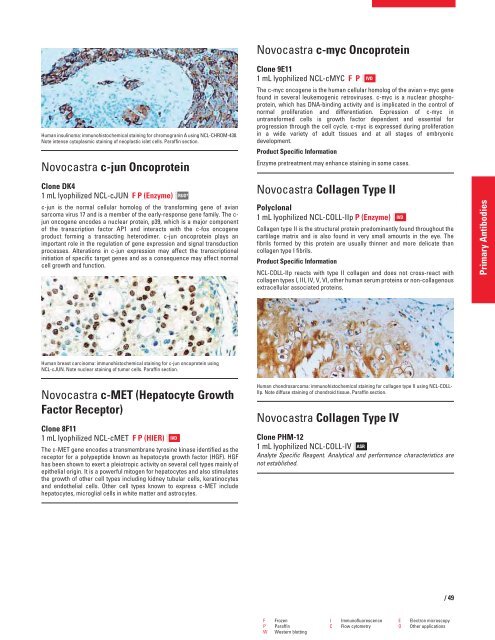QF0159 Marketing Release Record
QF0159 Marketing Release Record
QF0159 Marketing Release Record
You also want an ePaper? Increase the reach of your titles
YUMPU automatically turns print PDFs into web optimized ePapers that Google loves.
Human insulinoma: immunohistochemical staining for chromogranin A using NCL-CHROM-430.<br />
Note intense cytoplasmic staining of neoplastic islet cells. Paraffin section.<br />
Novocastra c-jun Oncoprotein<br />
Clone DK4<br />
1 mL lyophilized NCL-cJUN F P (Enzyme)<br />
c-jun is the normal cellular homolog of the transforming gene of avian<br />
sarcoma virus 17 and is a member of the early-response gene family. The cjun<br />
oncogene encodes a nuclear protein, p39, which is a major component<br />
of the transcription factor AP1 and interacts with the c-fos oncogene<br />
product forming a transacting heterodimer. c-jun oncoprotein plays an<br />
important role in the regulation of gene expression and signal transduction<br />
processes. Alterations in c-jun expression may affect the transcriptional<br />
initiation of specific target genes and as a consequence may affect normal<br />
cell growth and function.<br />
Human breast carcinoma: immunohistochemical staining for c-jun oncoprotein using<br />
NCL-cJUN. Note nuclear staining of tumor cells. Paraffin section.<br />
Novocastra c-MET (Hepatocyte Growth<br />
Factor Receptor)<br />
Clone 8F11<br />
1 mL lyophilized NCL-cMET F P (HIER)<br />
The c-MET gene encodes a transmembrane tyrosine kinase identified as the<br />
receptor for a polypeptide known as hepatocyte growth factor (HGF). HGF<br />
has been shown to exert a pleiotropic activity on several cell types mainly of<br />
epithelial origin. It is a powerful mitogen for hepatocytes and also stimulates<br />
the growth of other cell types including kidney tubular cells, keratinocytes<br />
and endothelial cells. Other cell types known to express c-MET include<br />
hepatocytes, microglial cells in white matter and astrocytes.<br />
IVD<br />
RUO*<br />
Novocastra c-myc Oncoprotein<br />
Clone 9E11<br />
1 mL lyophilized NCL-cMYC FP<br />
The c-myc oncogene is the human cellular homolog of the avian v-myc gene<br />
found in several leukemogenic retroviruses. c-myc is a nuclear phosphoprotein,<br />
which has DNA-binding activity and is implicated in the control of<br />
normal proliferation and differentiation. Expression of c-myc in<br />
untransformed cells is growth factor dependent and essential for<br />
progression through the cell cycle. c-myc is expressed during proliferation<br />
in a wide variety of adult tissues and at all stages of embryonic<br />
development.<br />
Product Specific Information<br />
Enzyme pretreatment may enhance staining in some cases.<br />
Novocastra Collagen Type II<br />
Polyclonal<br />
1 mL lyophilized NCL-COLL-IIp P (Enzyme)<br />
Collagen type II is the structural protein predominantly found throughout the<br />
cartilage matrix and is also found in very small amounts in the eye. The<br />
fibrils formed by this protein are usually thinner and more delicate than<br />
collagen type I fibrils.<br />
Product Specific Information<br />
NCL-COLL-IIp reacts with type II collagen and does not cross-react with<br />
collagen types I, III, IV, V, VI, other human serum proteins or non-collagenous<br />
extracellular associated proteins.<br />
Human chondrosarcoma: immunohistochemical staining for collagen type II using NCL-COLL-<br />
IIp. Note diffuse staining of chondroid tissue. Paraffin section.<br />
Novocastra Collagen Type IV<br />
Clone PHM-12<br />
1 mL lyophilized NCL-COLL-IV ASR<br />
Analyte Specific Reagent. Analytical and performance characteristics are<br />
not established.<br />
F Frozen I Immunofluorescence E Electron microscopy<br />
P Paraffin C Flow cytometry O Other applications<br />
W Western blotting<br />
IVD<br />
IVD<br />
/49<br />
Primary Antibodies
















